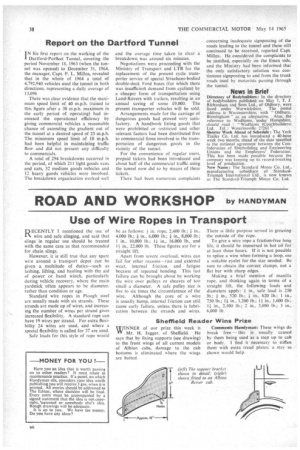ROAD AND WORKSHOP by HANDYMAN
Page 40

If you've noticed an error in this article please click here to report it so we can fix it.
Use of Wire Ropes in Transport
ECENTLY I mentioned the use of wire and safe slinging, and said that slings in regular use should be treated with the same care as that recommended for chain slings. However, it is still true that any spare wire around a transport depot can be given a multitude of duties—such as lashing, lifting, and hauling with the aid of power or hand winch, particularly during vehicle recovery, where the main yardstick often appears to be diameter, rather than condition or age.
Standard wire ropes in Plough steel are usually made with six strands. These strands are made up of wires, and increasing the number of wires per strand gives increased flexibility. A standard rope can have 19 wires per Strand. For extra flexibility 24 wires are used, and where a special flexibility is called for 37 are used.
Safe loads for this style of rope would be as follows: + in. rope, 2,400 lb.; in., 4,000 lb.; in., 6,000 lb.; in., 8,000 lb.; I in., 10,000 lb.; l in., 16,000 lb., and l-lin., 22,000 lb. These figures are for a straight lift.
Apart from severe overload, wires can fail for other reasons—rust and external wear, internal friction, and fatigue because of repeated bending. This last failure can be brought about by working the wire over pulleys or sheaves of too small a diameter. A safe pulley size is five to six times the circumference of the wire. Although the core of a wire is usually hemp, internal friction can still cause early failure, unless there is lubrication between the strands and wires.
There is little purpose served in greasing the 'outside of the rope.
To give a wire rope a friction-free long life, it should be immersed in hot oil for at least three hours. If it is not possible to splice a wire when forming a loop, use a suitable eyelet for the size needed. Be sure to obtain the correct clamps, not a flat bar with sharp edges.
Making a brief mention of manilla rope, and thinking again in terms of a straight lift, the following loads and diameters apply: + in.. safe load is 25G lb.; I in., 520 lb.; ; in., 620 lb.: 1 in., 750 lb.; 11 in., 1,200 lb.; 11in., 1,600 lb.; in., 2,100 lb.; 2 in., 3,800 lb.; 3 in., 6,000 lb.




















































































































